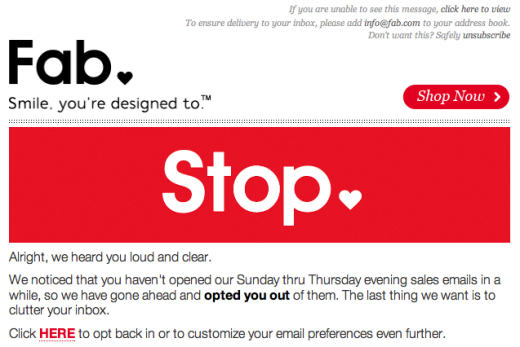William Shakespeare once said "Boldness be my friend," and if you're wondering how this relates to email marketing strategies, you may want to take a closer look at how you communicate with your customers prospects and subscribers.
A recent Hubspot blog post praised an "automatic opt-out campaign" used by ecommerce company Fab that decided to actually remove customers from its email lists if they hadn't opened the company's messages for a certain period of time.
Pretty bold, huh?
While all companies shouldn't blindly copy Fab's innovative email strategy, there are a few takeaways that will help you improve email response rates, reduce email complaints and bounces and get your remaining, engaged subscribers to beg for your emails.
Turn a Negative into a Positive
Marketers at Fab saw that recipients weren't opening their emails and created an opportunity to endear themselves to their subscribers.
What did Fab do? They proactively unsubscribed disengaged subscribers (!)
You read that right.
Fab automatically unsubscribes contact that have been innactive for a time period (6 ~ 12 months is a good starting point), and sends an email offering the opportunity to opt back in. Here's a copy of the email:
 |
This backward threat to end the business relationship can actually be an effective tool for engagement.
Your subscribers are most vulnerable when they are at risk to lose communication with your company, and this is where you can strike. By creating a targeted email segment of disengaged subscribers, you can offer them one last chance to interact with your company.
Taking this a step further, and after conducting some email marketing analysis, segment your email contacts into a few different categories by their levels of engagement:
- Ready and willing ('Actively Engaged'): These customers regularly open you email campaigns and often click. They look for ways to interact with your company.
- Moderate interest ('Partially Engaged'): Your company isn't their first choice for certain products or services, but they will look to your business in a pinch. These may be contacts that have opened 'a few' of your email marketing campaigns say, in the past 6 months.
- In need of resurrection ('Unresponsive'): These are contacts / leads / subscribers that haven't opened or responded to a single email campaign in the past 6 – 12 months.
Subscriber Preferences
Many of your contacts in the "moderate interest" category may move up to the next level of engagement if they are able to choose their amount of interaction. When customers subscribe to your email lists, instantly give them the opportunity to select how frequently they want to receive emails, or alternatively – allow them to select the types of emails to receive – like Blog article updates, product announcements and tips. Not only can this help improve your email campaign open rates and engagement, but it is will also start the customer relationship on the right foot by setting proper expectations. (By the way it's also a great idea to include a direct link to your privacy policy on your preferences and/or registration pages to help develop and foster trust.)
It turns out that major ISPs (Gmail. Yahoo, Hotmail,…) also factor in 'engagement rates' when deciding whether to place your email into the recipient's inbox. By removing contacts who have not opened any campaigns in the past year – you effectively improve your email open rates, which may also further improve your inbox placement.
Test Your Email Campaigns
You'll never know the effectiveness of your email marketing campaigns if you aren't testing which messages, subject lines and content your target customers prefer. In our blog webinar "Use Split Testing to Improve Email Response Rates", we ran a handful of split tests and presented our results. Here are a few that you should consider:
- Subject lines: By sending out two subject lines to random customers and measuring open rates, you will see which are most effective.
- Offers: Your targets will be tempted by some offers and thrown off by others, so test different initiatives to learn which work best.
- Send-From: The send-from address has a surprisingly high impact on email response rates. Test different variations.
The success of any business email marketing campaign starts with testing, and after you feel confident about your strategy, you can begin to be as bold as Fab dared to be. Pinpointe's multi-variant email testing, email reporting / analytics and smart segment features are just a few of the features that can help you to improve email response rates that you can try out for free, any time.






